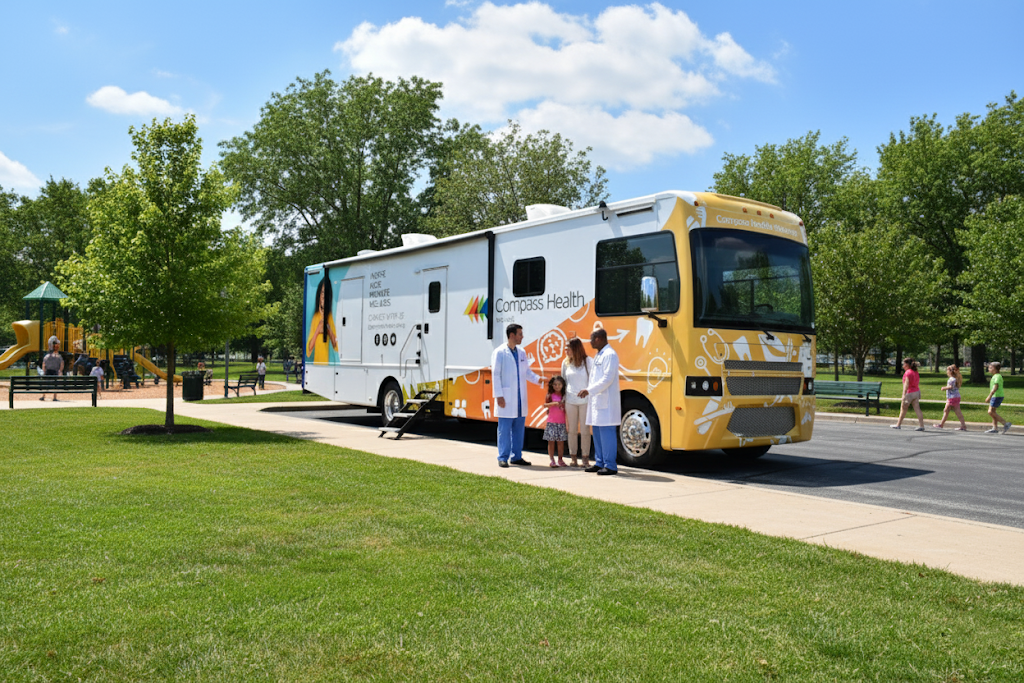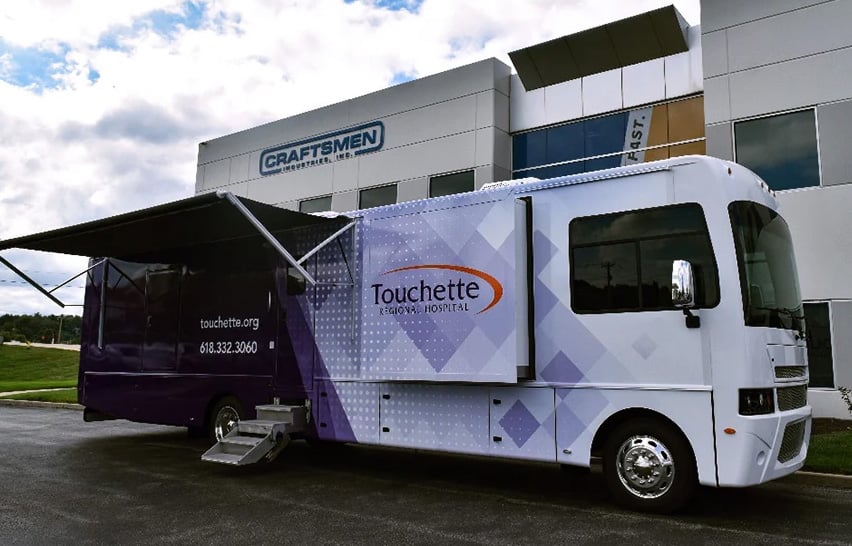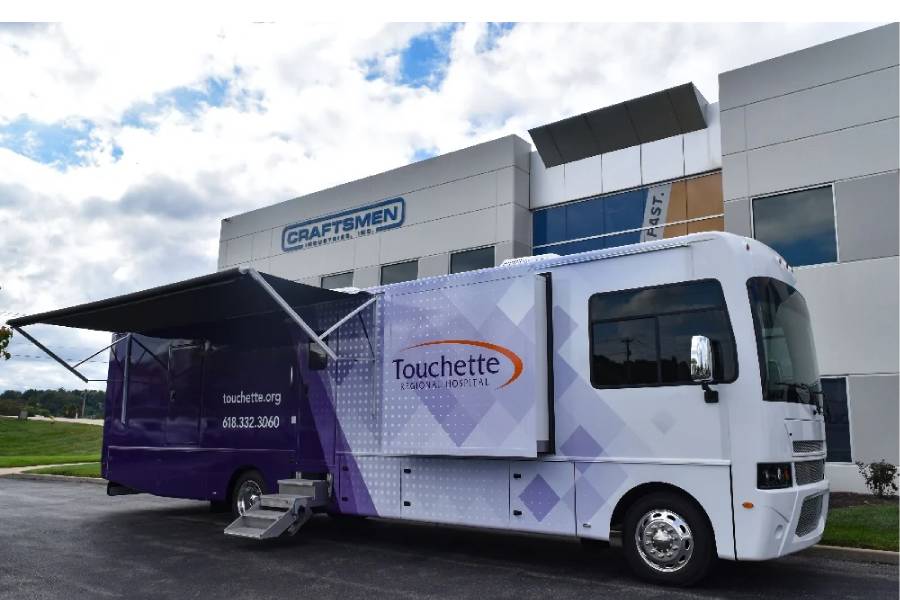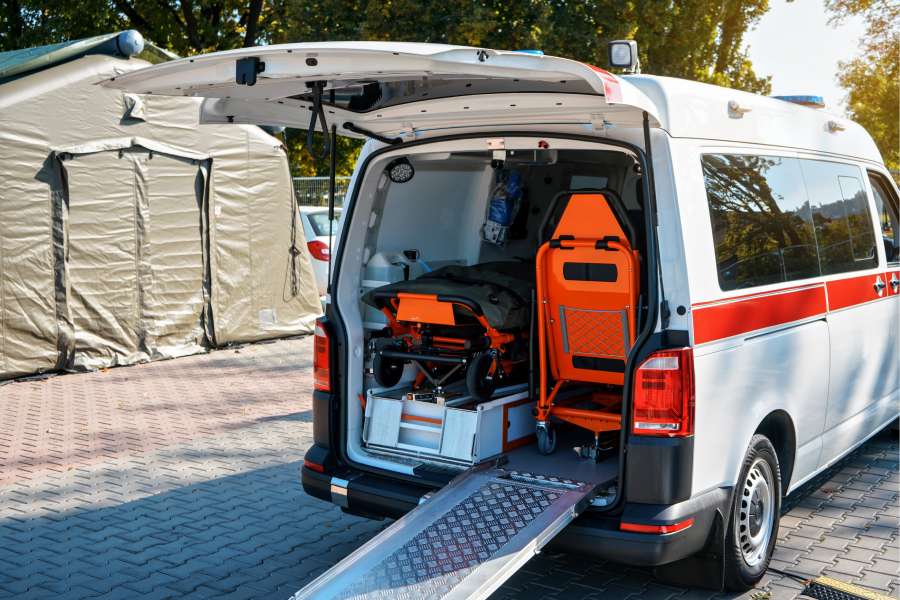Medical Coach vs. Medical Bus
In recent years, U.S. healthcare has significantly improved with the introduction of mobile clinics. Thanks to mobile services, medical personnel can...
10 min read
Craftsmen Industries Oct 20, 2025 5:15:12 AM

Mobile medical vehicles are moving clinics built into trailers, RVs, or trucks (not vans). Think of them as hospitals on wheels that bring care directly to communities, especially where access to traditional facilities is limited.
According to the U.S. Government Accountability Office (GAO), the Veterans Health Administration had 52 mobile medical units, though not all were active or fully treating patients. The question is, why do mobile medical vehicles matter today? First, they bridge healthcare gaps by delivering primary care, diagnostics, and outreach to underserved areas, including rural, urban, and disaster-stricken regions.
They support preventive health, from immunizations to screenings, reducing long-term burden on hospitals. In emergencies, such as during immunization campaigns or natural disasters, they enable rapid, flexible responses.
These mobile units improve health equity by reaching remote or marginalized populations, saving lives and resources. Read this blog to understand what mobile medical vehicles are and why they’re essential. This blog explores their types, features, and the critical role they play in transforming modern healthcare delivery.
Mobile medical vehicles are specially designed healthcare facilities on wheels that bring medical services directly to communities. Unlike standard ambulances or small vans, these units are built into trailers, recreational vehicles (RVs), or trucks, offering more space and flexibility to operate like mini-clinics or diagnostic centers.
The key difference lies in scale and capacity:
Mobile healthcare isn’t new. The concept dates back to the early 20th century, when traveling clinics were used to deliver tuberculosis screenings and maternal care in underserved regions. During World War II, military medical trucks became vital for battlefield care, setting the stage for today’s advanced mobile units.
Over the decades, they’ve evolved from simple check-up buses to fully equipped facilities capable of providing diagnostics, dental care, cancer screenings, and even remote services, such as telemedicine.
Mobile medical vehicles are more than just mobile clinics; they are essential tools for bridging healthcare access gaps, particularly in underserved and remote areas. By bringing services directly to patients, these vehicles help reduce barriers that traditional facilities often cannot overcome. Here’s why they matter:
Mobile medical vehicles come in various forms, each designed to meet specific healthcare delivery needs. Trailers, RVs, and trucks differ in mobility, capacity, and applications, making each suited for unique scenarios.

Mobile medical trailers are towable units equipped with full clinical facilities, allowing them to be stationed at multiple locations for patient care. They are commonly used for screenings, such as blood pressure checks, vision tests, mobile mammography services, and other diagnostic procedures.
Trailers are highly flexible and customizable, allowing healthcare providers to tailor them to the specific services they need to deliver. They are cost-effective for semi-permanent deployments at community centers or rural clinics.
Mobile medical RVs are self-contained vehicles equipped with built-in clinical spaces, enabling teams to operate independently without the need for a tow vehicle. They are ideal for multi-service mobile clinics, providing primary care, mobile dental services, and mental health support. RVs excel in long-distance outreach, traveling to underserved or remote communities where access to healthcare is limited.
Mobile medical trucks are smaller, highly flexible units equipped for specific clinical tasks or emergency response. They are frequently used in disaster relief and immunization campaigns, as well as smaller-scale community clinics. Trucks offer a compact solution that can reach areas inaccessible to larger vehicles.
While trucks are easy to maneuver and rapidly deployable, they offer less interior space and are limited in the range of services they can provide. They are best suited for targeted or emergency healthcare missions where mobility is the priority.
To ensure mobile medical vehicles deliver safe, efficient, and high-quality care, designers must focus on several critical attributes. Each of these features plays a crucial role in ensuring patient safety, enhancing staff efficiency, and improving the overall effectiveness of healthcare delivery.


Mobile medical vehicles have become indispensable in delivering healthcare services across diverse settings. Their versatility allows them to address specific needs in disaster relief, rural healthcare, corporate wellness, NGO operations, military healthcare, and government screenings. Some major use cases of mobile medical vehicles are,
Mobile medical units are deployed in disaster-stricken areas to provide immediate healthcare services when local facilities are overwhelmed or non-functional.
During the 2015 Nepal earthquake, NYC Medics dispatched a team to provide medical care in remote villages. Despite logistical challenges, the team established clinics in affected areas, offering essential medical services to survivors.
Benefits:
In rural and underserved regions, mobile medical vehicles bridge the gap by providing primary and specialized healthcare services to communities with limited access to healthcare.
Benefits:
Companies implement mobile medical well-being units to offer on-site health services, promoting employee well-being and reducing absenteeism.
General Motors' LifeSteps program provides mobile health services to employees, including health screenings and wellness education. This program aims to improve employee health and reduce healthcare costs.
Benefits:
In the United States, non-profit organizations play a vital role in extending healthcare services to underserved and marginalized communities. Many NGOs partner with hospitals, local health departments, and community centers to deploy mobile medical units that bring essential care directly to people who might otherwise lack access to treatment.
Mobile medical vehicles operated by nonprofits are often utilized for preventive care, including immunizations, screenings, and health education, as well as for providing services to vulnerable populations. These groups include homeless populations, migrant workers, and uninsured families.
Benefits:
Ensuring that mobile medical vehicles adhere to established standards is crucial for delivering safe, effective, and equitable healthcare services. These standards not only guarantee the quality and safety of the vehicles but also ensure that they meet the necessary regulatory requirements to operate legally and efficiently.
ISO 9001 is an international standard that sets out the criteria for a quality management system. It helps organizations ensure they meet the needs of customers and other stakeholders within statutory and regulatory requirements related to a product.
For mobile medical vehicles, ISO 9001 certification indicates that the manufacturer has a robust quality management system in place, ensuring consistent quality in production and service. This is vital for healthcare providers seeking reliable and durable mobile units.
AS9100D is a widely adopted and standardized quality management system for the aerospace industry. It encompasses all the elements of ISO 9001, along with additional requirements tailored to the aerospace industry.
While primarily for the aerospace sector, adherence to AS9100D demonstrates a manufacturer's commitment to quality and safety, which can be beneficial when procuring specialized mobile medical vehicles that require high precision and reliability.
The Americans with Disabilities Act (ADA) sets standards for accessible design, ensuring that facilities, including vehicles, are accessible to individuals with disabilities.
For mobile medical vehicles, ADA compliance ensures that the units are accessible to all patients, including those with mobility impairments. This includes features such as wheelchair ramps, suitable door widths, and interior layouts that accommodate mobility aids.
The Department of Transportation (DOT) sets regulations for the safe and efficient transportation of goods and passengers.
Mobile medical vehicles must comply with DOT regulations to ensure they are safe to operate on public roads. This includes adherence to weight limits, driver qualifications, and vehicle maintenance standards.
IEC 60601-1 is an international standard that outlines the safety and essential performance requirements for medical electrical equipment. For mobile medical vehicles, compliance with IEC 60601-1 ensures that all electrical systems and medical devices are safe to use, minimizing the risk of electrical hazards to patients and healthcare providers.
The Centers for Disease Control and Prevention (CDC) provides guidelines for infection control in healthcare settings, including mobile units. Adherence to CDC infection control guidelines ensures that mobile medical vehicles are equipped with necessary sanitation facilities, proper waste disposal systems, and protocols to prevent the spread of infections.
Building a mobile medical vehicle involves multiple cost components that can significantly affect the overall budget. Understanding these drivers is crucial for healthcare providers to make informed decisions and ensure the sustainability of their mobile units.
The vehicle base forms the foundation of any mobile medical unit and can be a van, RV, or truck. Costs vary widely depending on size, brand, and specifications, with an approximate cost of $45,000. The choice of vehicle base affects mobility, interior space, and long-term operational costs. Larger RVs or trailers offer more room for staff and equipment, but they may be more challenging to maneuver. In contrast, smaller vans are more agile but provide limited clinical space.
Customization and build-out costs encompass converting the base vehicle into a functional medical unit, including the necessary interior modifications, plumbing, electrical systems, and compliance-related modifications. Depending on design complexity, these costs typically range from $50,000 to $200,000.
The quality of materials, layout efficiency, and level of customization can dramatically impact both the cost and functionality of the vehicle. Attention to ergonomic design and workflow optimization is also critical, as it ensures staff can operate efficiently and patients receive care comfortably.
The medical equipment onboard defines the services the mobile unit can provide, including diagnostic tools, treatment devices, and laboratory instruments. Equipment costs range from $50,000 to $200,000, depending on whether the vehicle is equipped for basic primary care or specialized procedures.
Selecting appropriate equipment is crucial to ensure the vehicle meets its intended healthcare purpose without unnecessary overspending. Furthermore, durable, portable, and energy-efficient medical devices are preferred to maximize operational reliability and minimize maintenance challenges.
Ensuring the vehicle meets regulatory and safety standards is critical. Compliance upgrades, such as ADA accessibility, infection control surfaces, and electrical safety modifications, can add between $10,000 and $50,000 to the total build cost. These upgrades are essential for legal operation and to guarantee patient safety, primarily when the mobile unit operates in multiple jurisdictions.
Reliable power, HVAC, and IT systems are essential for maintaining patient comfort, operating medical devices, and supporting telemedicine or electronic health record systems. Depending on the specifications, these systems typically cost between $20,000 and $60,000. Proper integration ensures uninterrupted operations and a safe environment for both staff and patients.
The vehicle’s exterior branding or wraps help communicate the organization’s identity and promote the services offered. The costs for professional graphics typically range from $2,000 to $10,000, depending on the design complexity and materials. Effective branding enhances visibility and fosters trust with the communities served. It can also serve as a mobile advertisement, raising awareness about healthcare programs and driving engagement from target populations.
The landscape of mobile healthcare is rapidly evolving, driven by technological advancements and the increasing need for accessible medical services. One of the most significant trends is the integration of telemedicine, which enables mobile medical vehicles to connect patients in remote areas with specialists through virtual consultations, supported by technologies promoted by the National Institute of Biomedical Imaging and Bioengineering (NIBIB).
Another transformative development is the use of artificial intelligence (AI) diagnostics, which enable faster and more accurate disease detection. Systems like the VIGIL platform from the University of Michigan are enhancing rural healthcare by providing clinicians with real-time guidance. 5G connectivity is also reshaping mobile health by facilitating high-speed data transmission, real-time monitoring, and the integration of Internet of Medical Things (IoMT) devices.
Additionally, modular upgrades are making vehicles more flexible and scalable, with initiatives like ARPA-H’s PARADIGM program developing next-generation mobile clinics with customizable platforms that bring advanced diagnostics and healthcare services to underserved communities. These innovations collectively position mobile medical vehicles as a cornerstone of modern, technology-driven healthcare delivery, bridging gaps and expanding access to quality care.
Mobile medical trailer costs typically range from $250,000 to $450,000, depending on the size, type of medical equipment, and level of customization. Factors influencing cost include interior build-out, compliance upgrades, power/HVAC systems, and exterior branding.
The build timeline usually ranges from 4 to 9 months, depending on complexity. Typical stages include initial design and layout planning, fabrication and interior customization, medical equipment installation, and compliance testing for standards such as ADA and DOT.
Yes, mobile medical vehicles require liability insurance, fleet insurance, and coverage for onboard medical equipment. Clients typically secure policies through commercial insurers specializing in healthcare or specialty vehicles.
Mobile medical vehicles must meet ISO 9001 quality management standards, AS9100D aerospace-level quality standards, ADA accessibility requirements, and DOT road regulations. Procurement teams require documentation to ensure that vehicles are safe, compliant, and legally operable on public roads.
Yes, some mobile medical trailers are equipped for advanced care, including diagnostics, imaging (X-ray, ultrasound), and minor surgical procedures. These capabilities require specialized equipment, enhanced power systems, strict infection control measures, and compliance with relevant healthcare regulations.
Mobile medical vehicles have become a vital solution for expanding access to healthcare, particularly in rural, underserved, and emergency settings. By integrating advanced technologies such as telemedicine, AI diagnostics, and modular designs, mobile medical vehicles not only improve patient outcomes but also reduce healthcare inequality.
Compliance with standards like ISO 9001, AS9100D, ADA, and DOT regulations ensures that these vehicles are safe, reliable, and fully operational. For healthcare providers looking to enhance outreach and service delivery, investing in mobile medical vehicles is both practical and transformative.
Explore Craftsmen Industries and learn more about our medical trailers, mobile medical RVs, and compliance-ready vehicles to find the solution that fits your needs. Take the next step toward expanding your healthcare reach today!

In recent years, U.S. healthcare has significantly improved with the introduction of mobile clinics. Thanks to mobile services, medical personnel can...

Many people struggle with getting adequate medical care due to their circumstances. While some may find it difficult to find a medical facility due...

Mobile medical units are an essential part of remote healthcare. They’re crucial for patients needing immediate medical attention, and their lives...